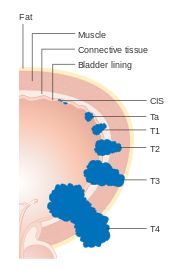Cancer staging systems
Cancer staging systems are used to prognosticate cancer and determine treatment. They classify cancers based on the extent of tumour or the location of the tumour in relation to where it arose.
Overview
Systems
- TNM staging system - most common, and used for the most common (adult) cancers.
- World Health Organization (WHO) grading system - for CNS tumours.
- St. Jude system - pediatric pathology.
- Durie-Salmon system - for multiple myeloma.
- Ann Arbour system - for Hodgkin lymphoma and non-Hodgkin lymphoma (excluding mycosis fungoides and Sezary syndrome).
- Sheldon system - for urachal carcinoma.[1]
- Modified Masaoka staging system - for thymoma.[2][3]
Stage
Most system are four tiered and use Roman numerals to denote the stage:
- Stage I: early cancer.
- Stage II: late early cancer (cancer between early and advanced stage).
- Stage III: advanced cancer - often defined by lymph node metastasis.
- Stage IV: late advanced cancer - often defined by metastasis.
TNM staging system
- Name of the system comes from the elements: Tumour, Nodes (lymph nodes), Metastasis (distant).
- Most common staging system.
- Staging parameters dependent on the specific site.
Modifiers
Table of modifiers:[4]
| Modifier | Meaning | Example | Notes |
|---|---|---|---|
| m | multiple tumours | pT(m)NM or pT2(2)N0Mx | tumour stage = highest stage of all the individual tumours |
| c | clinical stage | cTNM | if it is not specified clinical is assumed |
| p | pathologic stage | pTNM | derived from a surgical specimen or biopsy |
| a | stage at autopsy | aTNM | malignancy was not staged previously or treated - unless otherwise specified |
| y | staging after therapy | ypTNM | do not try to estimate pretreatment stage |
| r | recurrent tumour stage | rTNM | must have a clinically documented disease freedom |
Tumour stage
Usually determined by one of the following:
- Size of the tumour (maximal dimension).
- Depth of invasion.
Other factors:
- Lymphovascular invasion usually does not affect the tumour stage.
- Exceptions:
- Seminoma.
- Intrahepatic bile duct carcinoma.
- Hepatocellular carcinoma.[5]
- Exceptions:
- Margin status usually does not affect the tumour stage.
- Exception:
- Prostate adenocarcinoma - bladder neck margin positivity.
- Exception:
Nodal stage
- Lymph node involvement.
- Positive lymph nodes (without mets) often upstage to stage III.
- May upstage to stage II in some tumours.
- Sampling may be selective (sentinel lymph nodes).
Metastasis stage
See also
References
- ↑ Bruins, HM.; Visser, O.; Ploeg, M.; Hulsbergen-van de Kaa, CA.; Kiemeney, LA.; Witjes, JA. (Oct 2012). "The clinical epidemiology of urachal carcinoma: results of a large, population based study.". J Urol 188 (4): 1102-7. doi:10.1016/j.juro.2012.06.020. PMID 22901574.
- ↑ Mori, T.; Nomori, H.; Ikeda, K.; Yoshioka, M.; Kobayashi, H.; Iwatani, K.; Yoshimoto, K.; Iyama, K. (Feb 2007). "Three cases of multiple thymoma with a review of the literature.". Jpn J Clin Oncol 37 (2): 146-9. doi:10.1093/jjco/hyl147. PMID 17337514.
- ↑ Koga, K.; Matsuno, Y.; Noguchi, M.; Mukai, K.; Asamura, H.; Goya, T.; Shimosato, Y. (May 1994). "A review of 79 thymomas: modification of staging system and reappraisal of conventional division into invasive and non-invasive thymoma.". Pathol Int 44 (5): 359-67. PMID 8044305.
- ↑ URL: http://www.cancer.gov/cancertopics/pdq/treatment/breast/healthprofessional/page3. Accessed on: 28 March 2012.
- ↑ URL: http://www.cap.org/apps/docs/committees/cancer/cancer_protocols/2011/Hepatocellular_11protocol.pdf. Accessed on: 6 April 2012.
External links
- Cancer staging (cancer.gov) - an overview directed at individuals with cancer.
